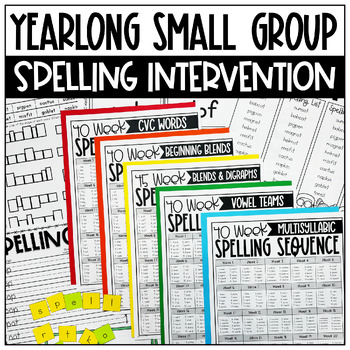Spelling Intervention & Curriculum for Special Education | Weekly Activities
- Zip
What educators are saying
Products in this Bundle (5)
Description
Does your spelling curriculum actually fit the needs of your students? As a special education teacher, I have students who need a tier 3 spelling intervention that makes sense for them. They need explicit spelling intervention in an order that makes sense and incorporates a constant review.
This spelling curriculum is designed for special education students. You'll find everything you need to have meaningful spelling practice for a full 40 weeks of school regardless of their decoding ability.
5 Levels of Spelling:
We all know that our students’ abilities vary. In this spelling intervention, you’ll find ten word, leveled lists that target:
- CVC Words
- Beginning Blends
- Blends, Digraphs, and CVCe
- Vowel Teams
- Multisyllabic Words
Each Level Includes:
- Printable Spelling Lists: These lists make it easy to staple the spelling list into their student agenda, leave at a station, share with instructional aides, or pass along to the general education teachers.
- Printable Spelling Homework & Activity Pages: Whether you’re needing in class assignments or homework for your students, you’ll find print and go pages that allow your students to practice their words easily.
- Making Words Practice Pages: One of the biggest parts of explicit instruction is taking the time to practice spelling each and every day. With the making words pages, you can do just that in a few minutes per day.
You’ll love how you can easily differentiate your spelling lists without spending hours brainstorming lists, accommodating grade level lists, or spinning your wheels with words that are too difficult.
You’ll also find that the sequence of these words makes more sense than most textbook spelling that you’ve used. You students will slowly master phonics skills in this spelling intervention rather than memorize words simply to pass a test.
You’ll also find:
- Blending Board Cards
- Real and Nonsense Word Sorts
- Phonemic Awareness Activities (which vary by level)
Other Special Education Teachers Said:
“My learning support students struggled with the spelling lists that came with the reading curriculum. The words were just getting too difficult sometimes OR the lists had too many skills in one list. This spelling curriculum focuses on one skill which will make spelling so much easier.”
“Loved the variety of activities for each week. My students who are receiving special education services love the routine of each week. I have seen a real improvement!”
“I've never found a spelling resource that worked quite like I wanted it to for my special education students, but this one does! Oftentimes, I find resources for only self-contained classrooms and that was not feasible for myself, as a resource teacher. “


